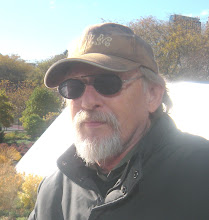Yang 8 and all
that
Attending a
beginners’ class in the Yang 8 Form, I was looking to recapture the first-time experience
of learning Tai Chi I once had as well as to obtain inspiration for “getting
back into it” as my hiatus had been way too extensive. Well, the “just like
riding a bicycle…you never forget” syndrome set in almost immediately. I did,
however, learn. I learned that errors can be remembered in a sort of muscle
memory kind of way. This is a good thing because now you can correct mistakes. Remembering
not to rock as you shift your weight, not to straighten your arms or legs…maintaining
the “bow” shape to insure softness and the potential for following an aggressor’s
energy.
Why the
particular postures in Yang 8? Our teacher Ron talked about the 13 Essentials
of Tai Chi. That sounded familiar. I have a fairly good library of books on Tai
Chi, so I dug out my well-worn copy of T'ai Chi Classics by Waysun Liao.
And I googled. Beware of the Internet (The jaws that bite, the claws that catch!): this is the age of
misinformation and misinformed information. But I found many references to the
13 Principles, the 13 Postures, the 13 Etcetras. Most made sense.
I have always enjoyed exploring Michael P.
Garofalo’s web posts on all things Taijiquan. At https://www.egreenway.com/taichichuan/powers13.htm
he comments on the 13 Principles and I quote:
“The Thirteen Postures (8 Gates and 5 Steps) are
referred to in various ways by T'ai Chi Ch'uan authors. Some call them the ‘Thirteen Powers = Shi San
Shi.’ Others call them the Thirteen
Postures, the Thirteen Skills, the Thirteen Entrances, the Thirteen Movements,
or the Thirteen Energies.
The first Eight Gates or Eight Entrances (Ba Gua
or Pa Kau) can be divided into the Four Primary Hands (Ward Off, Pull Back,
Press and Push) and the Four Corner Hands (Pull Down, Split, Elbow and
Shoulder).
The first eight (Pua Qua or Ba Gua) of the
Thirteen Gates are often associated, for mnemonic or esoteric purposes, with the
eight basic trigrams used in the Chinese I Ching: Book of Changes. In the order of the first Eight Gates (Pa-Men),
the eight I Ching trigrams are Heaven, Earth, Water, Fire, Wind, Thunder, Lake,
and Mountain.”
And so we have:
1. Ward
Off - Peng
2. Roll Back
- Lu
3. Press -
Ji
4. Push -
An
5. Pull
Down - Tsai
6. Split -
Lieh
7. Elbow -
Chou
8.
Shoulder - Kao
9.
Advancing Steps - Jin
10.
Retreating Steps - Tui
11.
Stepping to the Left Side - Ku
12.
Stepping to the Right Side - Pan
13.
Settling at the Center – Ding
David Bao in his posting at
https://davidbao.com/2017/01/06/thirteen-principles-of-tai-chi/
explains that “The first eight principles are subtle energies/forces applied
while practicing Tai Chi. They are known as the Eight Gates. The first four are
the Four Main Directions while the other four are the Corners. …The last five
principles are the five steps (footwork) which are based on the Five Elements. This
five steps move the person’s body around smoothly and with stability.”
So we have:
Eight Trigrams 八卦
1. Peng 掤 –
Outward Expansion (South/Heaven)
2. Lu 捋– Roll Back (North/Earth)
3. Ji 挤 – Press Forward
(West/Water)
4. An 按 –
Push Downward (East/Fire)
5. Cai 采 –
Pull Down (SW/Wind)
6. Lie 挒– Split (NE/Thunder)
7. Zhou 肘-
Elbow Stroke (SE/Lake)
8. Kou 靠– Shoulder Stroke
(NW/Mountain)
Five Elements 五行
9. Jin Bu 进步
– Step Forward (Metal)
10. Tui Bu 退步–
Step Backward (Wood)
11. Zuo Gu 左顾-
Look Left (Water)
12. You Pan 右盼 –
Look Right (Fire)
13. Zhong Ding 中定 –
Central Equilibrium (Earth)
Returning to
our discussion of Yang 8 we can point to all of the above. In Reverse Reeling Forearms
we see looking forward and backward (and in Repulse Monkey we have stepping
backward as well). In the second movement, Brush Knee, which is done to the
left then to the right I see Pressing Forward, Pull Down and Split. Parting the
Horse’s Mane is also called Ward Off and we find that in the First Gate. And so
forth.
In all Tai Chi
movements we should apply these principles: sinking the shoulders and dropping
the elbows, relaxing the chest and sinking the Qi down to the Dan Tian (centering
energy), lifting the head, and using the mind to move the body instead of using
force. Stillness in movement. Smooth and even flow in turning and stepping. In short,
connecting the mind with the Qi.

